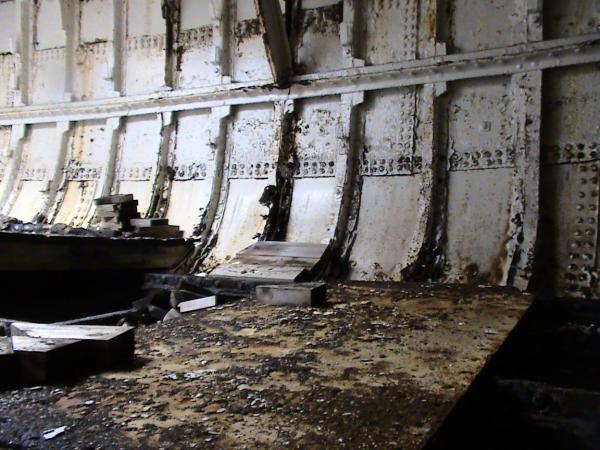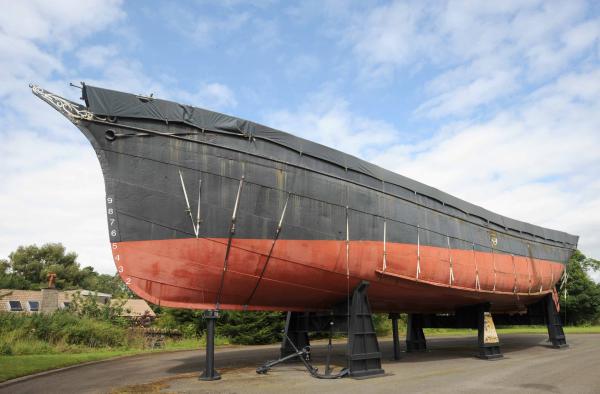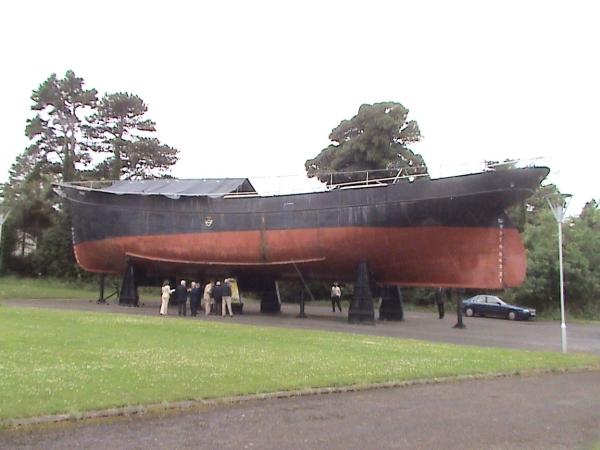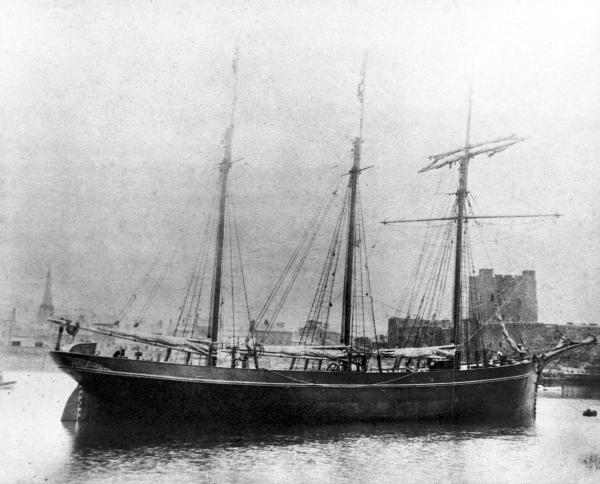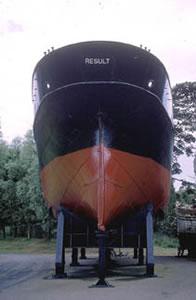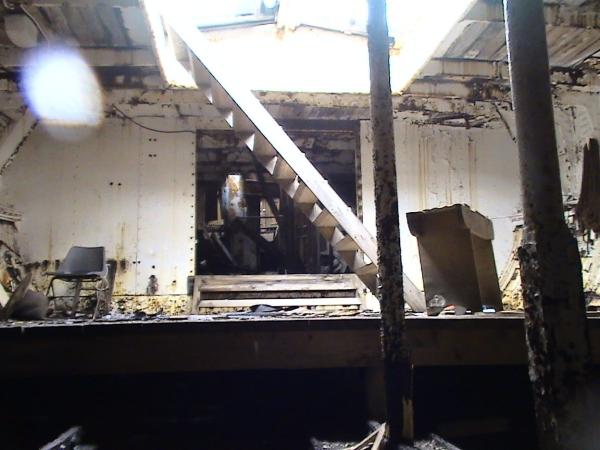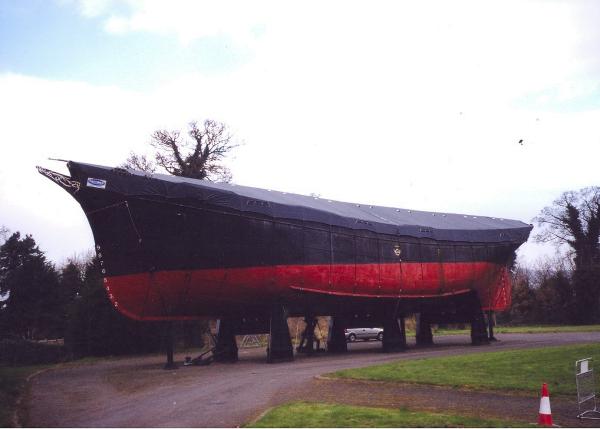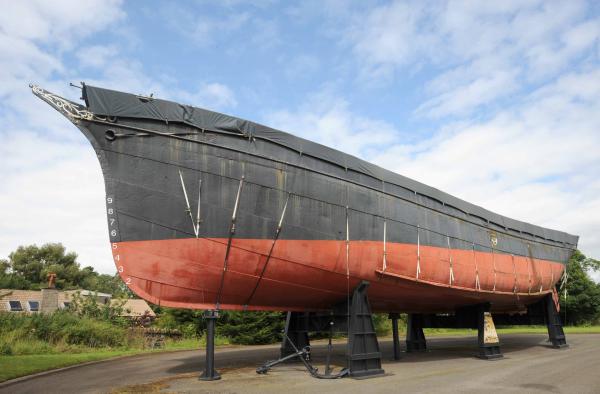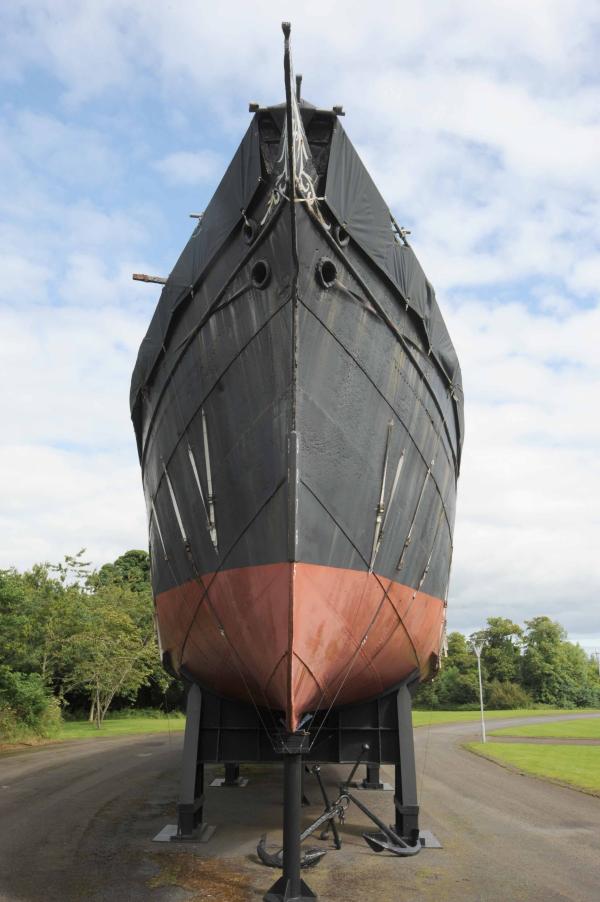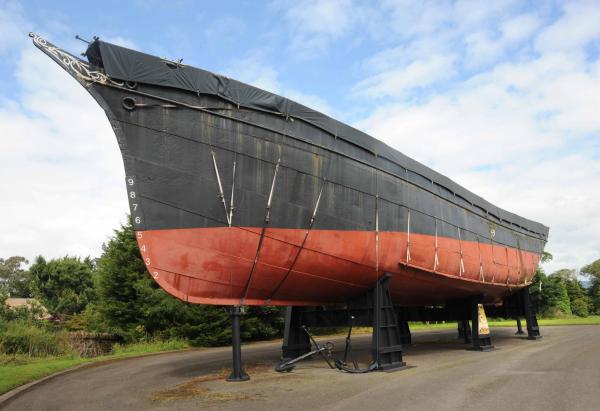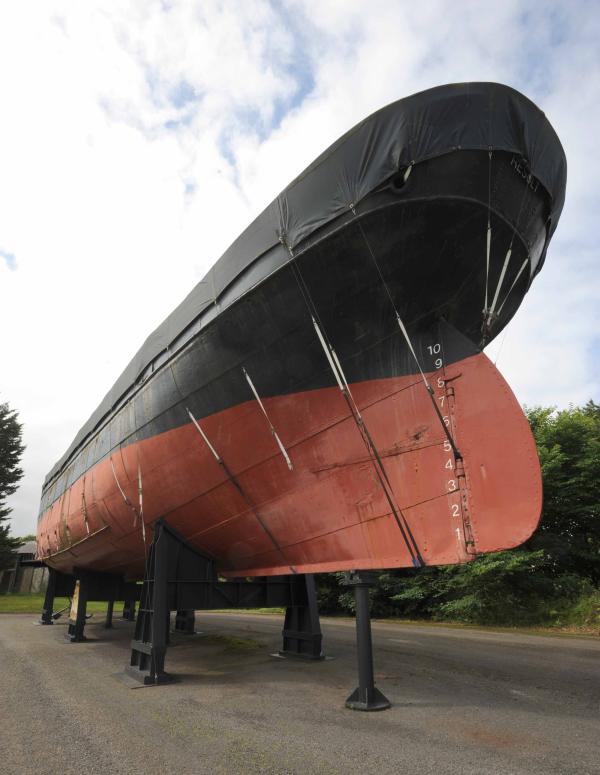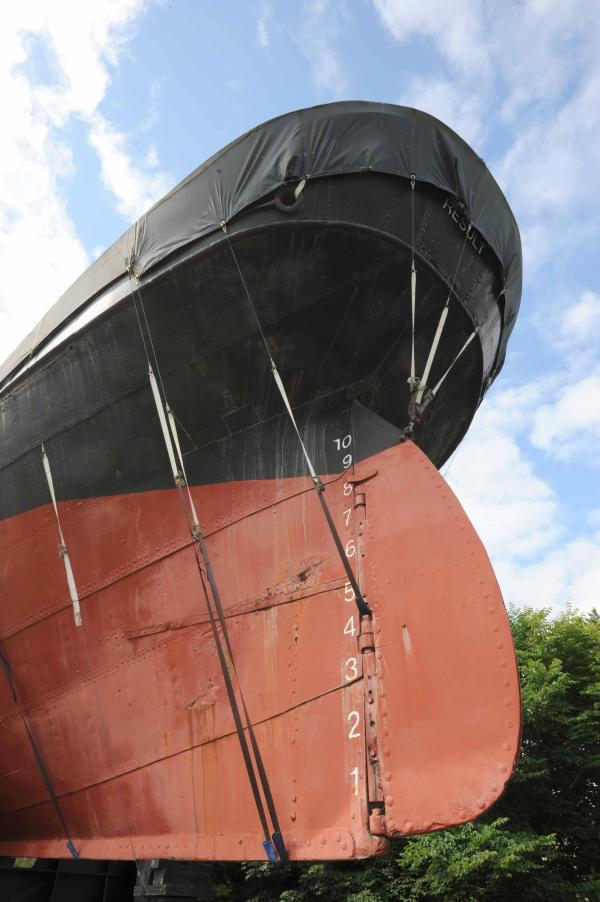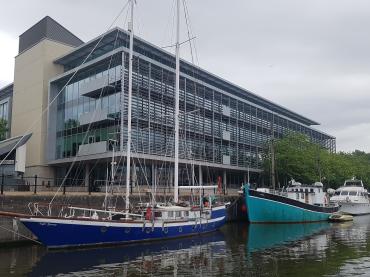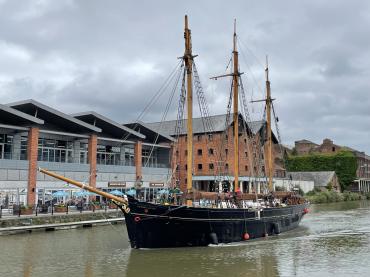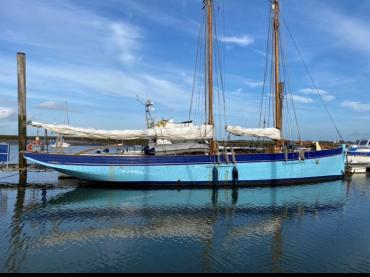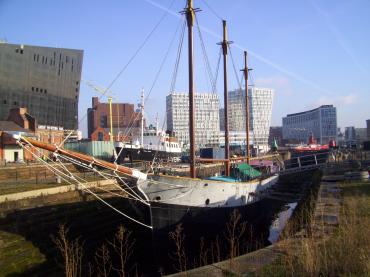

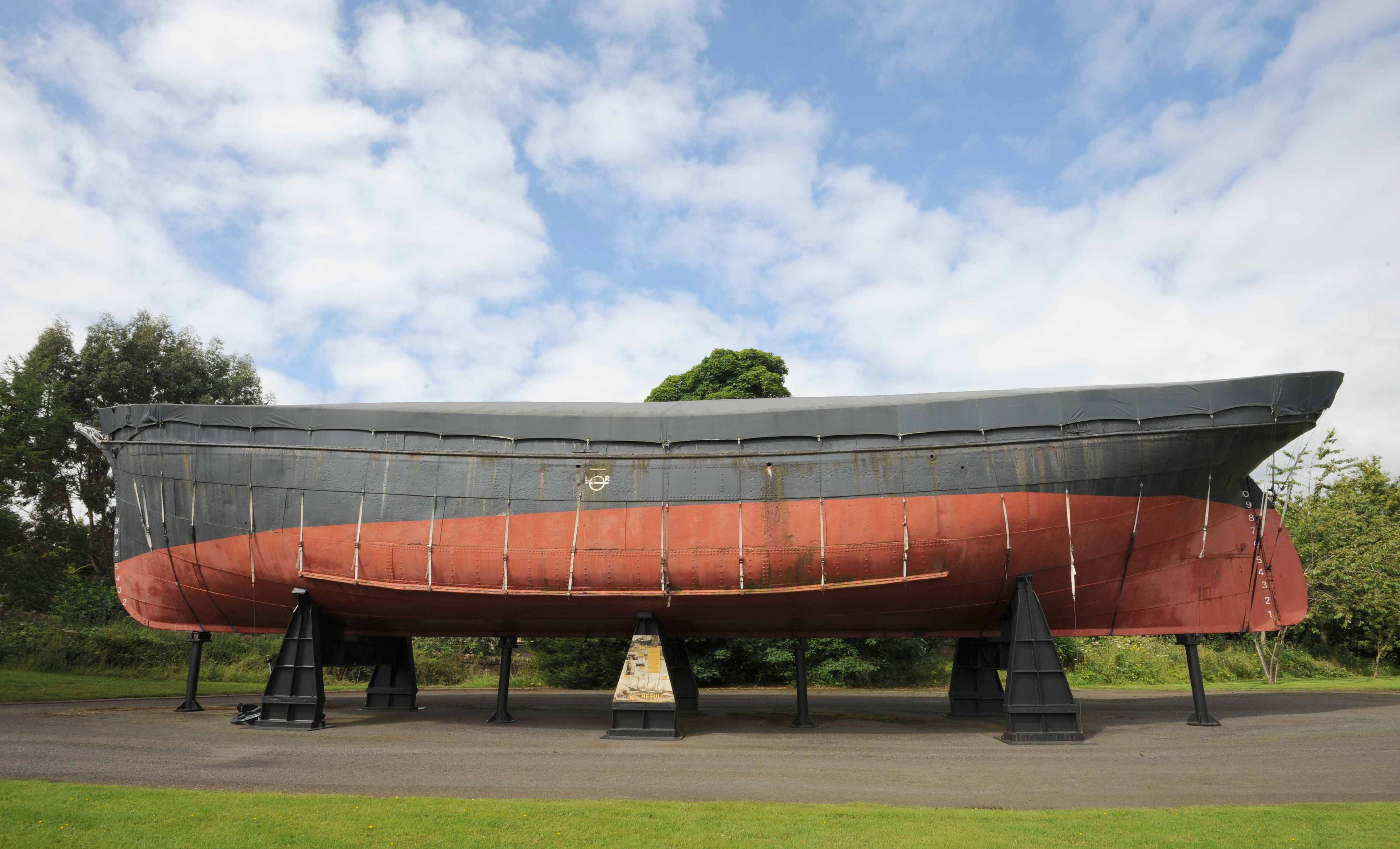
Previous names
- 1917 - 1917 Q-23
Details
Construction
Dimensions
History
The schooner RESULT was a contemporary of KATHLEEN & MAY that continued working until 1967, and differed from her in being built of steel rather than wood. She was launched in January 1893 by Robert Kent & Co., of Carrickfergus on Belfast Lough, for Thomas Ashburner & Co., and was registered at Barrow. Ashburner lived at Connah’s Quay near Chester, (where KATHLEEN & MAY's first owner also lived), and it was from there that his fleet mainly operated. He had ordered RESULT from Paul Rodgers, a renowned schooner builder at Carrickfergus, but Rodgers got into financial difficulties and had to sell out to Robert Kent of Ayr, under whose name she was completed.
RESULT's lines were more graceful and yacht-like than many schooners because her design was conceived by Richard Ashburner, a yacht designer, and Paul Rodgers, who had built well-regarded yachts. She had a counter stern, and clipper bows with a generous sheer, and was rigged as a three-masted topsail schooner with double square topsails on her foremast. At first a flying topgallant was also set on her foremast, but this was soon landed. Her good looks were complemented by her speed, for she was one of the fastest of the later schooners. RESULT's trade from Connah’s Quay took herto Ireland, the Isle of Man and Furness. In 1908 she was sold to Captain Henry Clarke of Braunton, North Devon, where she was the largest of the port’s fleet of coastal sailing vessels. In 1914 she was fitted with a 45 BHP auxiliary engine, and her square topsails and yards were removed.
In November 1916 she was requisitioned by the Admiralty and was converted at Lowestoft to a decoy ship, numbered Q23, in January 1917. The Q-ships carried a concealed armament with which they hoped to sink a U-boat that believed it was attacking a merchant ship, and indeed some successfully did this. RESULT was armed with two 12 pounder guns, fore and aft of the mainmast, a 6 pounder gun forward and two fixed 14 in. torpedo tubes aft, and her square topsails were reinstated by the navy. She encountered her first U-boat at the southern end of the Dogger Bank on 15 March 1917 and was engaged by UC45 at a range of about 2000 yards. As the submarine closed on her the schooner opened fire and scored two hits on the conning tower, causing UC45 to dive and retreat from the scene. RESULT suffered damage, mainly to her sails and rigging – the foresail alone had thirteen holes in it. Another U-boat was engaged later on the same night. RESULT fired a torpedo which missed, and there was an exchange of gun fire, apparently without either ship being hit, before the submarine dived and made off. On 5 April, near the North Hinder Light a third submarine was encountered, and RESULT was hit amidships by a 4.1 in. shell, setting the magazine on fire and injuring two of the ammunition party. Again when shereturned fire the submarine dived and the Q-ship dropped a depth charge which led to the U-boat’s retreat.
In August 1917 RESULT was returned to her owners who once more removed the square topsails, though they were later reinstated in one of the many alterations to her rig over the years. In 1921 she carried slate from Porthmadog to the continent, and later in the 1920s was working the short sea trade along the south coast. By this time her ownership was shared between Captains Clarke and Welch and in the 1930s the latter acquired full ownership. During the Second World War RESULT carried coal in the Bristol Channel trade from south Wales ports. In 1946 she was refitted, her topmasts were removed and a 120 BHP engine was installed.
At some point the mainmast was removed and RESULT continued as an auxiliary ketch, trading in the Bristol Channel, along the south coast, and to the Channel Islans and French Channel ports until 1967. With cargoes in short supply Welch decided to convert the hold into passenger accommodation for charter work, but he died before this could be completed. RESULT was taken into the care of the Exeter Maritime Museum for three years and was then sold by Mrs Welch to the Ulster Folk and Transport Museum, arriving in Belfast Lough in 1970. In 1979 she was craned out of the water at Belfast and taken on a road transporter to be put on display, without masts, on dry land at the museum at Cultra, County Down, where she remains.
Source: Paul Brown, Historic Sail, The History Press.
Significance
1. What is the vessel’s ability to demonstrate history in her physical fabric? Evidence for designs, functions, techniques, processes, styles, customs and habits or uses and associations in relation to events and people. How early, intact or rare these features are may impact on significance.
Built by Paul Rodgers of Carrickfergus Shipyard in collaboration with Thomas Ashburner & Co and her future captain Robert Wright, RESULT’s design blended function with graceful features that can still be seen in her fabric today. In her original form she represented the highest technical development of the coastal schooner but has subsequently undergone continuous modifications in response to changing economic and political circumstances. Her First World War service is evidenced through a piece of her hull damaged during a U-boat encounter. This has survived showing the entry point and has been removed from the ship for display in a nearby gallery.
In 1979, conservation work was undertaken by Harland & Wolff to return the vessel to her original 1893 specification which included reducing the hatchways to their original dimensions, fitting smaller steel coamings, removing a wheelhouse added in 1946, as well as the engine, propeller and the plating of the propeller aperture. She has remained largely stripped out with her rig removed since. Some original fittings survive, and some internal fittings have been replicated, including the wheelhouse. Other parts, such as the bunk beds, are in poor condition. The lower decks are in poor condition with areas unsafe and at risk of collapse. The hull form is at build with no changes to its shape, other than an entry point cut into one of the plates in the bottom to enable access from the ground.
2. What are the vessel’s associational links for which there is no physical evidence?
Associations with people or places. Off-ship research.
RESULT was the first metal ship built by Paul Rodgers, a renowned boat-builder, but she was then completed by Robert Kent & Co after Rodgers went bankrupt. She has strong associations with Ireland, the Isle of Man and Furness where she traded during her early life and is now the last remaining Ulster built ship of the hundreds that plied their trade around the coasts of Britain and Ireland and were once of such importance to coastal communities. RESULT is iconic for many, having been a regular sight in Belfast Lough at the turn of the century and is remembered as the largest ship ever to have entered the port of Braunton, North Devon in 1909 when she was purchased by a local consortium of ship owners.
Her role as a decoy or ‘Q’ ship in the First World War gives her both national and international significance. She encountered her first two U-boats within a 24-hour period in March 1917. Having hit and damaged the conning tower of the first, she subsequently suffered damage to her sails and rigging, the foresail receiving thirteen hits. In April 1917 she encountered another submarine and was hit amidships by a shell which set the magazine on fire. Her post-war life saw continued operations as a trading ship with links across the Bristol Channel, the South Coast and as far afield as the Channel Islands and French Channel ports. She remained operational during the Second World War and carried cargo in the coastal and home trades until 1967, by which time she had become the last vessel of her type to be registered at a British port.
RESULT exemplifies Ireland’s trading legacy with her connections to commerce, human endeavour and conflict. She has left a lasting memory with many of those who engaged with her, not least the Welch family who owned her for over thirty years as a family trading business and fondly recall her use as a family home during the summer. Written accounts of RESULT's Q-ship service survive and there are numerous photographs documenting her life as well as plans. She was also featured in the 1951 Carol Reed film ‘Outcast of the Islands’. RESULT was added to the National Register of Historic Vessels in 1996 with the status of being on the National Historic Fleet.
3. How does the vessel’s shape or form combine and contribute to her function?
Overall aesthetic impact of the vessel, her lines, material she was built from and her setting. Does she remain in her working environment?
RESULT's lines were more graceful and yacht-like than many schooners because her design was the work of Richard Ashburner, a yacht designer, and Paul Rodgers, who built highly regarded yachts. With her counter stern and clipper bows, plus her distinctive sheer line, she was aesthetically pleasing. Built for speed, she was one of the fastest of the later schooners and her transition to auxiliary sail reflected her owners’ successful efforts to work her profitably within rapidly changing patterns of transport and distribution. As the coastal trade involved working into tidal harbours and estuaries, she was specially strengthened for loading aground.
In March 1914 she was fitted with an auxiliary engine to improve her profitability. and her square topsails and yards were removed. On being requisitioned by the Admiralty in January 1917 she was converted into a decoy ship, and armed with two 12 pounder guns, fore and aft of the mainmast, a 6 pounder gun forward and two fixed 14 inch torpedo tubes aft. Her square topsails were reinstated by the Navy. Post-1917 RESULT was returned to her owners who once again removed the square topsails, though they were later reinstated. From then on RESULT traded as a motor ketch. In 1946 she was refitted, her hatches were enlarged to facilitate cargo handling, a new larger engine was fitted, her topmasts were removed and a wheelhouse added on deck. Her mainmast was also later removed and she continued as an auxiliary ketch with her hold partially converted into passenger accommodation.
RESULT is now a static exhibit, located out of the water in the grounds of the Ulster Folk and Transport Museum at Cultra, near Belfast, where she was built. She has been on display in a purpose-built cradle outside the galleries since 1979 looking out towards Belfast Lough where she once sailed. Despite being displayed with minimal interpretation and no rig, as a museum exhibit, she still portrays the history of the coastal and Irish Sea merchant sailing trade.
Author:
Clare Ablett 17/2/22
Key dates
-
1893
Built by Robert Kent & Co at Carrickfergus Shipyard, County Antrim and registered at Barrow
-
1893-1908
Traded from Connah’s Quay to Ireland, the Isle of Man and Barrow-in-Furness
-
1908
Sold to Captain Henry Clarke of Braunton, North Devon
-
1914
Fitted with a 45 BHP auxiliary engine, her square topsails and yards removed
-
1916
Requisitioned by Admiralty and converted at Lowestoft to a decoy ship, numbered Q23 Armed and square topsails reinstated
-
1917
Encountered and engaged three U-boats
-
1917
Returned to her owners who removed the square topsails
-
1921
Refitted as a single topsail schooner to carry slate from Porthmadog to the Continent
-
1939-45
Carried coal in the Bristol Channel
-
1946
Refitted: topmasts removed, a 120 BHP engine installed, a new wheelhouse fitted and hatches enlarged
-
1946-67
Traded in the Bristol Channel
-
1970
Sold by Mrs Welch to the Ulster Folk and Transport Museum and arrived in Belfast Lough
-
1979
Craned out of the water at Belfast and underwent restoration. Taken by road for display ashore at the museum at Cultra, County Down
Sources
Lake, Deborah, Smoke and Mirrors
Brouwer, Norman J, International Register of Historic Ships, Anthony Nelson, pp171, Edition 2, 1993
Sullivan, Dick, Old Ships, Boats and Maritime Museums, Coracle Books, 1978
Simper, Robert, Maritime Heritage: Survivors of Coastal Sail, pp49-52, Sep-Oct Volume 2.3, 1998
McCaughan, Michael, Ships Monthly: Result goes home, pp20-23, March 1980
Own this vessel?
If you are the owner of this vessel and would like to provide more details or updated information, please contact info@nationalhistoricships.org.uk

